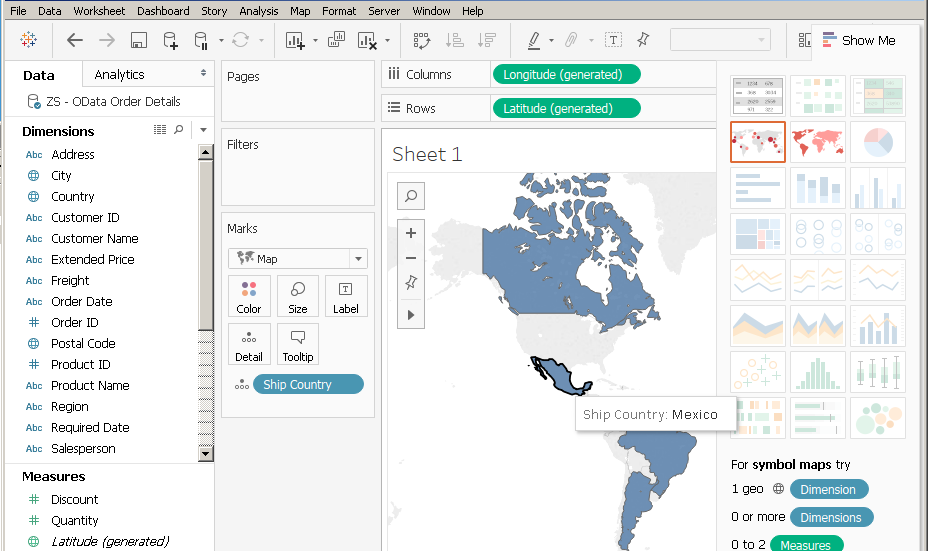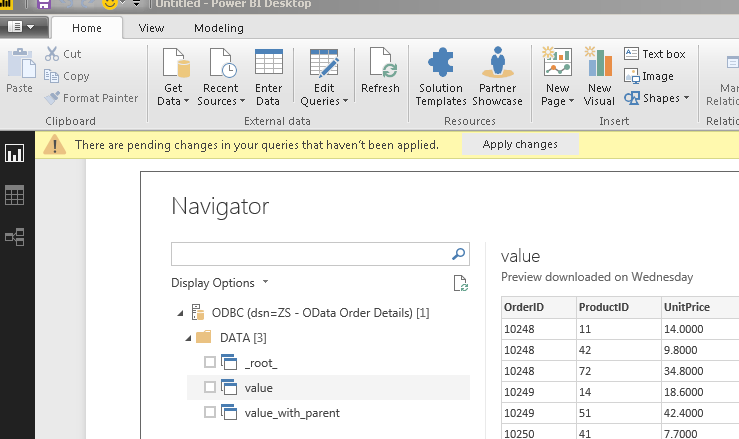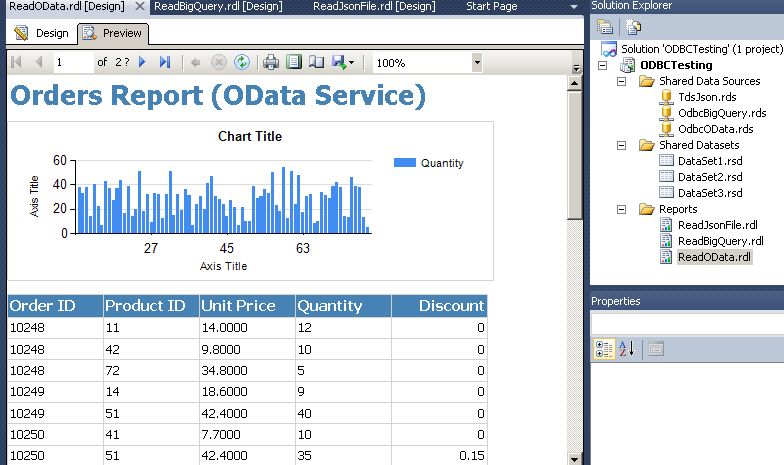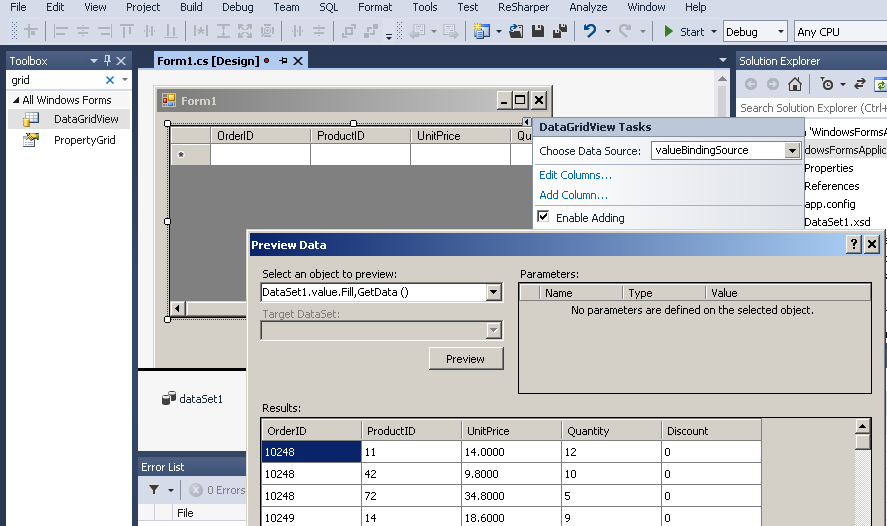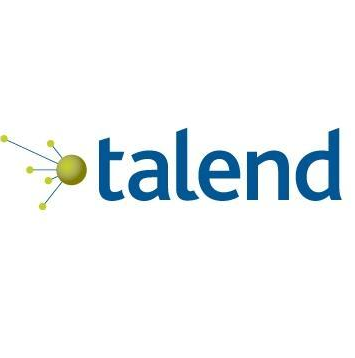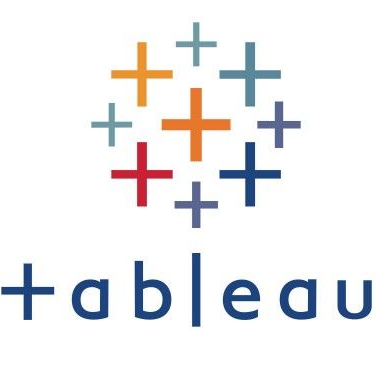
JSON ODBC Driver for REST API and filesJSON ODBC Driver can be used to read / write data from Web API / Cloud Data sources or Local JSON files. Easily integrate virtually any Web API inside your BI / ETL / Reporting / Tools or Programming Languages. Write familiar SQL queries to read /write data. This driver supports latest API security standards (i.e. OAuth 2.0, JWT, X509), and optimized for large data files. This driver comes with native support for SQL Server using Data Gateway. This driver is using same high performance data processing engine which was originally developed for JSON / REST Connector in SSIS PowerPack. ODBC PowerPack and SSIS PowerPack, both products share many UI elements and concepts. We wrote many articles to explain various features in one product but concepts are mostly same in both products so hope you can reuse steps explained in different articles even though screenshots /steps may be slightly different. Feature Summary
|
|
| Download Help File Buy | View All Drivers |
Featured Articles
|
Integration Scenarios (Reporting / ETL / BI / Programming)
ZappySys ODBC Drivers built using ODBC standard which is widely adopted by industry for a long time. Which mean the majority of BI Tools / Database Engines / ETL Tools already there will support native / 3rd party ODBC Drivers. Below is the small list of most popular tools / programming languages our Drivers support. If your tool / programming language doesn’t appear in the below list, which means we have not documented use case but as long as your tool supports ODBC Standard, our drivers should work fine.
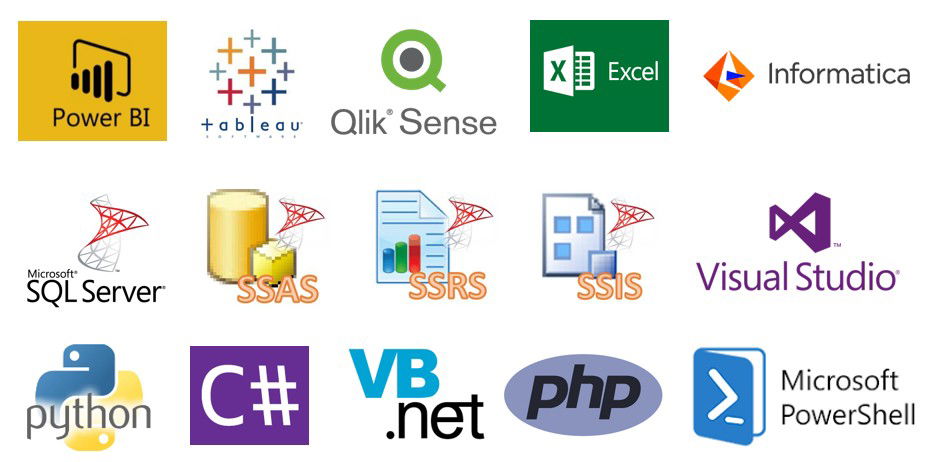
ZappySys Drivers for REST API, JSON, XML – Integrate with Power BI, Tableau, QlikView, QlikSense, Informatica PowerCenter, Talend, SQL Server, SSIS, SSAS, SSRS, Visual Studio / WinForm / WCF, Python, C#, JAVA, VB.net, PHP. PowerShell
|
BI / Reporting Tools |
|
ETL Tools |
|
|
Programming Languages |
|
ODBC Integration Screenshots in various tools
Access Live REST API / JSON data inside Microsoft SQL Server (T-SQL)
ZappySys has developed a unique bridge called ZappySys Data Gateway Service (ZSDG) which can help to access our Drivers in SQL Server or JAVA based Apps or Non-Windows OS (e.g. Mac, Linux). ZappySys Data Gateway service can run in the cloud (VM Exposed to internet) or you can install locally on-premises.
Client application can connect to Data Gateway Service using any Microsoft SQL Server compatible driver (i.e. SQL Server ODBC, OLEDB, ADO.net or JDBC Driver or Linked Server in SQL Server). Data Gateway can be installed on the central server where you can have many users who can connect to Data Gateway to use ZappySys Drivers without installing anything on their machine. Data Gateway Service understands TDS Protocol and Client App can be running on any machine or operating system (MacOS, Linux, Windows).
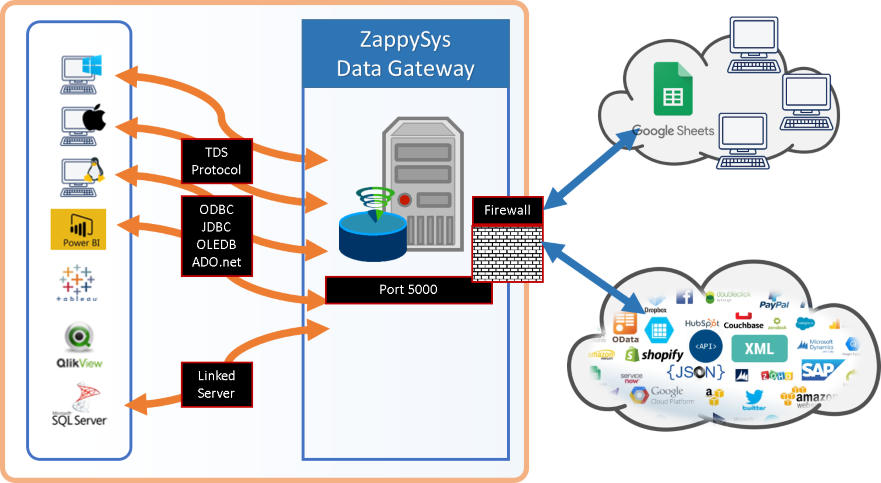
ZappySys Data Gateway – Connect to JSON, XML, OData, REST API, SOAP data sources using TDS protocol compatible drivers (or any SQL Server ODBC, JDBC, OLEDB, ADO.net driver )
Microsoft SQL Server Integration using Data Gateway Service (T-SQL)
Here is one possible use case of using Data Gateway Service. Any DBA or Non-Programmer can start writing T-SQL queries to use ZappySys Drivers (e.g. REST API, JSON, XML, CSV data source) right inside your usual T-SQL code (You can access data from Salesforce, REST API, JSON, XML, CSV inside Views, Functions or SQL Stored Procedures).
This approach can eliminate any possible ETL work needed to extract data outside of SQL Server, you can start using your existing SQL Skill to achieve previously hard to achieve scenarios without coding.
For many other possible use case of Data Gateway click here.
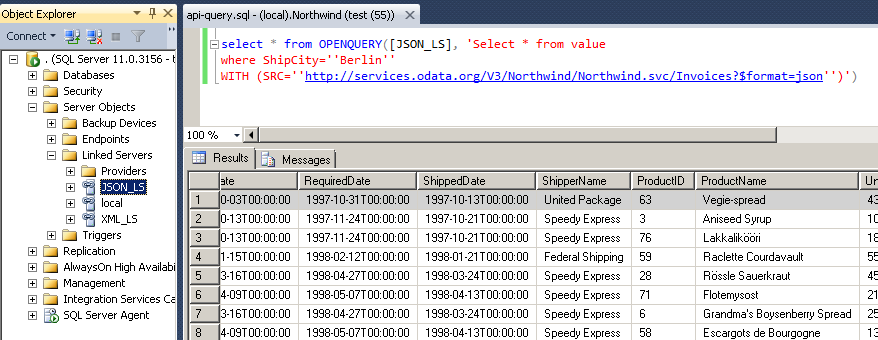
SQL Server Integration Example – Query REST API / JSON Files / XML Files inside SQL Server using ZappySys Data Gateway Service (Use of Linked Server / OPENQUERY Feature in T-SQL Code / SSMS)
Video Tutorial – Calling ZappySys Drivers inside SQL Server (JSON / REST Driver use case)
Here is a short video to demonstrate a use case of Data Gateway. With this approach you can import data from REST API or any other data source for which ZappySys offers Drivers (e.g. Amazon S3, Azure, SFTP, Salesforce, XML , CSV)
SQL Query Language Examples
ZappySys introduced most innovative way to transform your complex API into Flat table using familiar SQL Query Language. Here are some examples of SQL Queries our drivers understand.
To see all examples check this link (JSON / REST examples) Select correct driver node in help file – e.g. JSON here, XML here, CSV here
Familiar SQL Syntax (Where, Group By, Order By)
/* SQL Language Support to query API or JSON/XML Files */ SELECT Country as Invoice_Country, SUM(UnitPrice * Quantity) Total FROM value WHERE Discount > 0 GROUP BY Country HAVING SUM(UnitPrice * Quantity)>1000 ORDER BY Total DESC WITH (SRC='https://services.odata.org/V3/Northwind/Northwind.svc/Invoices?$format=json')
Read from Local File
/* Query JSON/XML File(s) */ SELECT * FROM $ WITH (SRC=@'C:\Data\Customer*_??.json')
GET data from URL (Read Example)
SELECT * FROM value WITH ( METHOD='GET', SRC='https://services.odata.org/V3/Northwind/Northwind.svc/Invoices?$format=json' )
POST data to URL (Write Example)
/* Submit data to API - POST Request. You can POST data from file content or supply body as direct string.*/ SELECT * FROM $ WITH ( METHOD='POST' ,HEADER='Content-Type:text/plain||x-hdr1:AAA' ,SRC='http://httpbin.org/post' ,BODY='@c:\files\dump.json' ,IsMultiPart='True' )
API Pagination – Paginate based on URL Path (Loop until no record)
This example shows how to paginate API calls where you need to pass page number via URL Path. Driver keeps incrementing page number and calls next URL until last page is detected. There are few ways to indicate last page (e.g. By status code, By row count, By response size). If you don’t specify end detection then it will use default (i.e. No records found).
SELECT * FROM $ WITH ( SRC='https://zappysys.com/downloads/files/test/cust-<%page%>.json' ,PagingMode='ByUrlPath' ,PagingByUrlAttributeName='<%page%>' ,PagingByUrlEndStrategy='DetectBasedOnRecordCount' ,IncrementBy=1 )
Advanced URL JOIN – Pass parent URL data to Child URL
This example shows how to perform URL JOIN. Using this pattern you can pass parent URL data to child API URL in one query. You can pass parent data in child URL or Body (for POST). Placeholder syntax is [$parent_alias.parent_col_name$]. Each level must have ALIAS attribute. For root level you dont have to Prefix JOINxxxxxxx but for any other level you must Prefix JOINxxxxx before each attribute name. For more information on API JOIN Pattern check https://zappysys.com/links/?id=10092
SELECT c.custid,c.name,c.city ,o.orderid,o.orderdate,o.total /* ,i.itemid,i.qty,i.shipped */ FROM $ WITH( --1st level (root)-- Src='https://zappysys.com/downloads/files/test/join/customers.json' ,NextUrlAttributeOrExpr='$.nextpage' ,Filter='$.customers[*]' ,Alias='c' ,WaitTimeMs='500' --2nd level-- --You can pass parent column to child URL using placeholder [$parent_alias.parent_col_name$] syntax (e.g. [$c.custid$] ) ,Join1_src='https://zappysys.com/downloads/files/test/join/c[$c.custid$]/orders.json' ,Join1_filter='$.orders[*]' ,Join1_alias='o' ,Join1_NextUrlAttributeOrExpr='$.nextpage' ,Join1_WaitTimeMs='500' /* --3rd level-- --You can pass parent column to child URL using placeholder [$parent_alias.parent_col_name$] syntax (e.g. [$c.custid$] and [$o.orderid$]) ,Join2_src='https://zappysys.com/downloads/files/test/join/c[$c.custid$]/o[$o.orderid$]/items.json' ,Join2_filter='$.items[*]' ,Join2_alias='i' ,Join2_NextUrlAttributeOrExpr='$.nextpage' ,Join2_WaitTimeMs='500' --maximum 7 levels deep you can go. Any attributes allowed in WITH clause can be prefixed by by joinN_xxx -- join3_xxxxx, join4_xxxxxx .......... join7_xxxxx */ )
URL JOIN Pattern – Download files to local disk / Use functions
This example shows how to download files to local disk. It first gets records by calling first URL and then pass it to seconds URL. For more information on API JOIN Pattern check https://zappysys.com/links/?id=10092
SELECT a.url,b.data,file_write_binary(base64_to_bytes(b.data) ,'c:\temp\' || name ) as bytes_written from $ WITH ( SRC='https://zappysys.com/downloads/files/test/imagelist.json', FILTER='$.list[*]', ALIAS='a', JOIN1_SRC='[$a.url$]', JOIN1_ALIAS='b', JOIN1_SaveContentAsBinary='true' )
Query Large Compressed File (From URL or Local disk)
This example shows how to read very large file from local disk or URL. You can read uncompressed or compressed file (in our example its GZip compressed file). Using –FAST option in your Filter enables Streaming Mode. To use STREAM Mode you must turn off IncludeParentColumns option as per the example.
SELECT * FROM $ --LIMIT 10 WITH( Filter='$.LargeArray[*]--FAST' --//Adding --FAST option turn on STREAM mode (large files) ,SRC='https://zappysys.com/downloads/files/test/large_file_10k_largearray_prop.json.gz' --,SRC='C:\Data\large_file*.json.gz' ,IncludeParentColumns='False' --//This Must be OFF for STREAM mode (read very large files) ,FileCompressionType='GZip' --Zip or None (Zip format only available for Local files) )
Support for various authentication types
ZappySys Drivers support various authentication types
| Option | Description |
|---|---|
| Notset | Not set |
| Windows | Default Windows Credentials – Current User Credentials |
| Basic | Basic – UserID/Password |
| NTLM | NTLM – UserID/Password/Domain |
| Kerberos | Kerberos – UserID/Password/Domain |
| SoapWss | SOAP WSS – UserID/Password in SOAP Body |
| Token | Static Token / API Key |
| TokenDynamic | Dynamic Token – Two Step Auth (i.e. Login to get token) |
| TokenJwt | JWT Token (RFC 7519) |
| HashSignature | HMAC Signature (i.e. Request Hashing using Key / Password) |
Custom 2 Step Auth – Dynamic Token Example
This example shows how to call REST API Service using Dynamic Token approach. Learn how to authenticate using userid / password to obtain temporary token which can be passed to call API. Also learn how to pass Body, Headers using HTTP POST. For more information about Dynamic Token visit https://zappysys.com/links/?id=10091
SELECT * FROM $ WITH( Src='https://zappysys.com/downloads/files/test/rest-getdata.aspx?format=json' --,RequestMethod='POST' --,RequestData='{sessionid: "[$token$]"}' ,Filter='$.rows[*]' ,Header='Content-Type: application/json || Accept: */* || Cache-Control: no-cache' ,DataConnectionType='HTTP' ,CredentialType='TokenDynamic' ,UserName='MyUser001' ,Password='P@$$w0rdAAc12' ,AuthScheme='{none}' ,TokenUrl='https://zappysys.com/downloads/files/test/rest-login.aspx' ,TokenRequestData='{ user:"[$userid$]", password:"[$password$]" }' ,TokenRequestMethod='POST' ,TokenResponseContentFilter='$.sessionid' ,TokenRequestHeaders='Content-Type:application/json | Accept:*/* || Cache-Control:no-cache' ,TokenResponseContentType='Json' )
Basic Authentication Example (Userid / password based)
SELECT * FROM $ WITH ( SRC='http://httpbin.org/basic-auth/user1/pass123', DataConnectionType='HTTP', CredentialType='Basic', UserName='user1', Password='pass123' )
OAuth 2.0 Authentication Example
SELECT * FROM $ WITH ( SRC='https://www.googleapis.com/analytics/v3/metadata/ga/columns' ,UseCustomApp='True' ,DataConnectionType='OAuth' ,ServiceProvider='Google' ,ClientId='3855xxxxxx-xxxxxxxxxxxxxxxxx.apps.googleusercontent.com' ,ClientSecret='qF7axxxxxxxxxxxWfs' ,AccessToken='ya29.GlsxxxxxxxxxIam' ,RefreshToken='1/pFOxxxxxxxxxxgU' )
REST / SOAP API Call Settings
Our drivers come with easy to use API query builder with many advanced options to connect to virtually any JSON, XML or CSV based data format from local files or API URL.
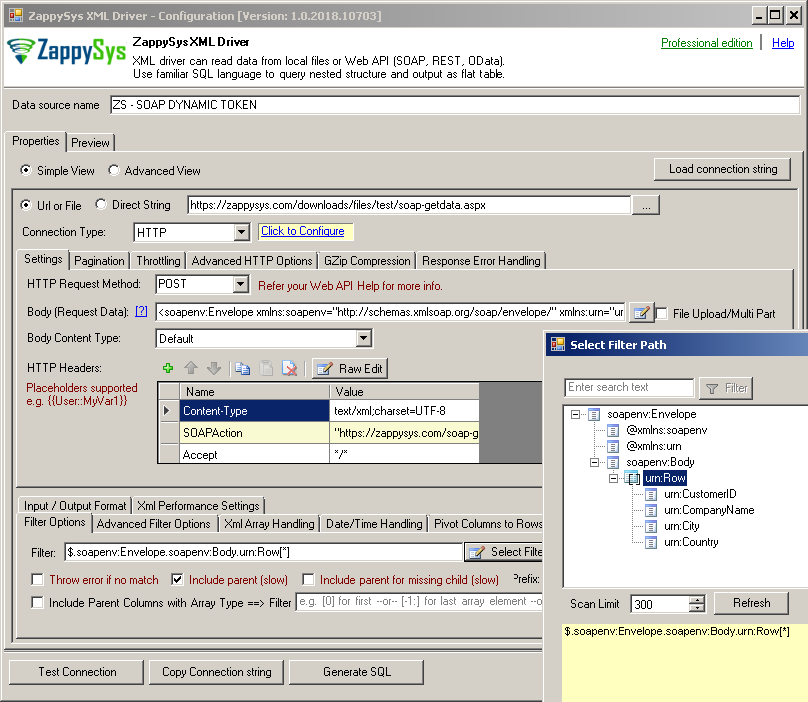
ZappySys Driver UI – setting to read from File or API URL. Read from JSON REST API / XML SOAP Web Service / CSV Format.
SQL Query Editor / Live Preview / Examples
Our drivers come with easy to use Query editor so you can test any API
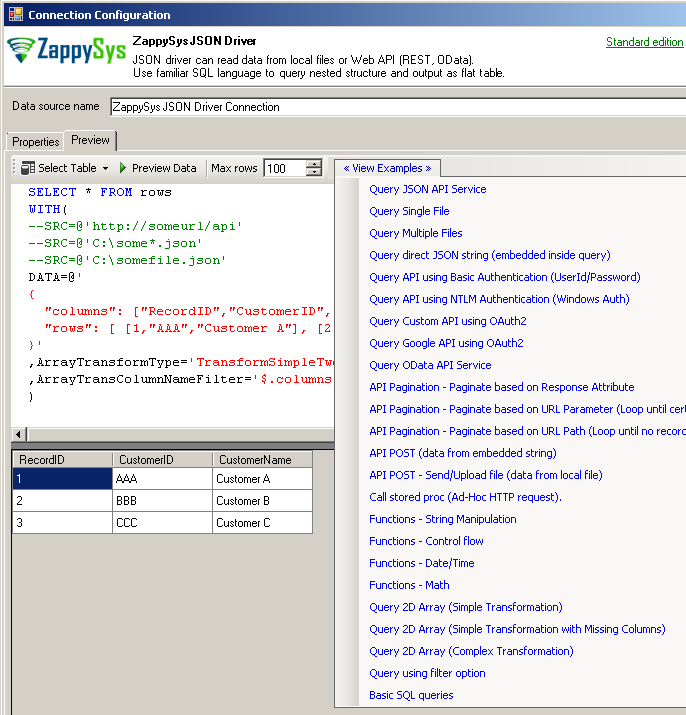
ODBC Driver – SQL Query Editor / Live Preview
Security Standards (OAuth, JWT, Basic Auth, X509)
Our ODBC Drivers tested with wide variety of security standards such as OAuth 1.0, OAuth 2.0, Basic Auth, JWT, X509 Certificate. We also support latest encryption standards for secure http (such as SSL/TLS 1.2)
Here is an example of our easy to use OAuth Connection Manager which can be used to connect to any API with OAuth 1.0 or OAuth 2.0 Standards.
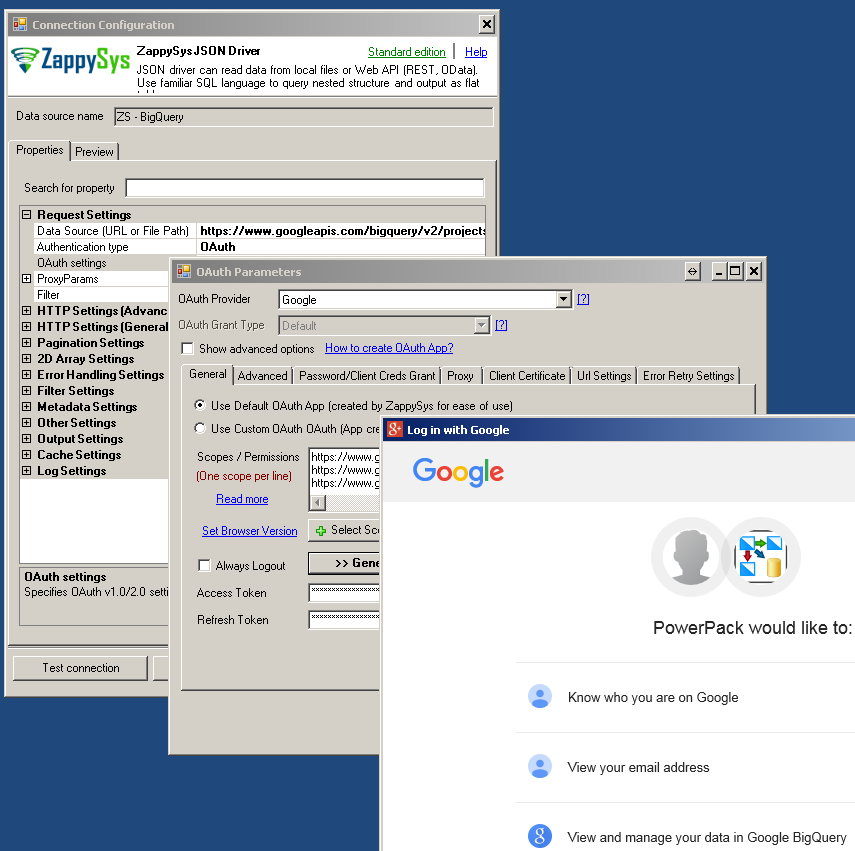
OAuth Connection for API Providers (Such as Facebook, Google, Twitter, Linkedin, Amazon, Hubspot, MailChimp…)
Step-By-Step Video Tutorial (6 Parts Video Series)
Here is full length tutorial if you like to get started with ZappySys Drivers. Below tutorial shows usecase of REST API integration in Excel and Power BI. It covers many topics such as below. We used JSON Driver as an example but many concepts mentioned in below tutorial can be applicable to all other ZappySys drivers.
- Configure ODBC DSN
- Making HTTP GET Calls
- Authenticating REST API requests
- Pagination in REST API
- Building simple and advanced SQL Queries
- POST data to REST API
- Excel Example – Import REST API in Excel
- Power BI Example – Import REST API in Power BI
Articles
Click here to see all articles for [JSON File / REST API Driver] category
Read data from QuickBooks Online into SQL Server via JSON DriverIntroduction QuickBooks Online is a well-known Cloud-based Accounting Software. In this post, you will learn how to implement QuickBooks Online API Integration with SQL Server or any other RDBMS (e.g. Oracle, MySQL, Postgresql) using ODBC in few clicks. We will use ODBC JSON / REST API Driver to read data from QuickBooks Online and Load into SQL Server / other targets (Using OAuth […] |
Read / Write REST API data in Talend (JSON / XML / SOAP)Introduction In this post we will learn how to read / write REST API data in Talend Open Studio. We will create a simple Talend Job using ZappySys JSON Driver to read from REST API / JSON Files and load into Target (e.g. File / DB). Techniques listed in this article can be also used to read […] |
Insert, Update and Delete JIRA Issue in SQL ServerIntroduction In our previous blog we saw how to read JIRA data in SQL Server. In this blog, we will learn how to Insert, Update and Delete Issue in JIRA using ZappySys JSON Driver. We will also read data from SQL Server data table in stored-procedure and insert JIRA issues in bulk, along with few other […] |
Read JIRA data in SSRS Reports (SQL Server Reporting Services)Introduction In our previous blog we saw how to read rest api in SSRS reports. We recommend you go through that article first. In this post we will look at specific example on How to read JIRA data in SSRS Reports (SQL Server Reporting Services), along with few other topics such as how to generate an […] |
How to Import JIRA data in Power BI using JSON DriverIntroduction In our previous blog we saw how to import rest api in Power BI. We recommend you go through that article first. In this article, we will learn how to Import JIRA data in Power BI. For that, we will create a successful HTML Connection then request for reading JIRA data and loading into Power […] |
Get Office 365 data in Power BI using Microsoft Graph API and ODBCIntroduction In this article, we will get Office 365Â data in Power BI using Microsoft Graph API and ODBC drivers. Specifically, we will get Excel file data in OneDrive, events from a Calendar and finally, a list in a note in OneNote and then load that data into a Power BI report. We will achieve […] |
Push data into a Power BI dataset from SQL Server using JSON DriverIntroduction In this article, you will learn how to push data into a Power BI dataset from SQL Server. Power BI is a Microsoft reporting product that can get data from virtually any source and display it nicely in a report or a dashboard. Among its dataset types, it has a streaming dataset into which […] |
Load JIRA data into SQL Server with REST API DriverIntroduction In this blog, we will learn How to Load JIRA data in ODBC and load JIRA data into SQL Server Table, along with few other topics such as how to generate an API Token using Atlassian Account for JIRA REST API Call, how to read all Issues data from JIRA with ODBC. We will go through […] |
Import REST API in Tableau – Read JSON, SOAP XML, CSVIntroduction Tableau is one of the most popular Reporting / Visualization tool for BI / Data analytics. It comes with many out-of the box connectors to pull data from some popular data sources but still it seriously lakes capability to consume data from millions of other REST / SOAP data sources out there for which […] |
How to call REST API in MicroStrategy using JSON Driver / XML Driver (SOAP) Introduction In this new article, we will show how to call REST API in MicroStrategy. MicroStrategy is a Business Intelligence company that provides powerful software to create nice charts, reports to take decisions. It started in 1993 and now it is one of the most popular Business Intelligence tools in the world because it is simple, intuitive and friendly. […] |

